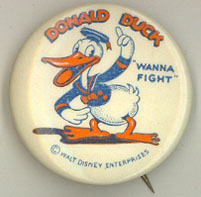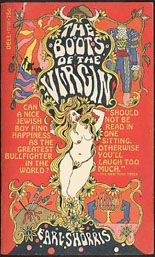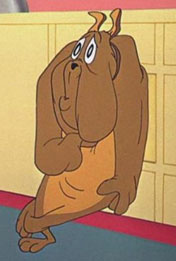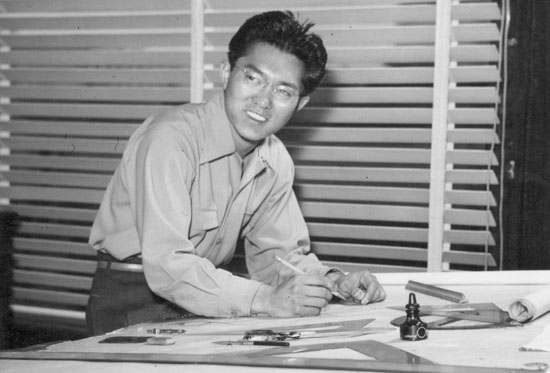 Donald’s Fighting Pose. In the earliest Donald Duck cartoons, the little quacker was quite pugnacious and audiences immediately laughed when he took his fighting pose. That pose was created by animator Dick Lundy who stated, “The fighting pose was used whenever Donald reached his frustration level. I had him lean forward, chin out, arm straight out and fisted while the other arm with fist was swaying back and forth. His one foot was out straight, heel on floor, the other foot under him as he hopped up and down, quacking. For its time, the action was considered quite violent.”
Donald’s Fighting Pose. In the earliest Donald Duck cartoons, the little quacker was quite pugnacious and audiences immediately laughed when he took his fighting pose. That pose was created by animator Dick Lundy who stated, “The fighting pose was used whenever Donald reached his frustration level. I had him lean forward, chin out, arm straight out and fisted while the other arm with fist was swaying back and forth. His one foot was out straight, heel on floor, the other foot under him as he hopped up and down, quacking. For its time, the action was considered quite violent.”
Snoopy’s Voice. In 1995, animator and director Bill Melendez recalled that when working on the first Peanuts special, cartoonist Charles Schulz wasn’t very happy with the attempts to have Snoopy make a noise that sounded a lot like “arf arf” or a real dog. Melendez stated, “I thought about it and tried different things. I ended up recording myself going ‘wow-wow-wowww’ and sped it up so it had a quick funny sound like ‘bup-bup-bup’. It gave Snoopy a unique voice.”
 Melendez’s Two Animation Dreams. In 1995, animator and director Bill Melendez was working on producing two dream animation projects. “The Boots of the Virgin” by Earl Shorris and “The Whale” by Jeremy Lucas were planned to be full length animated features based on books that were out of print. Melendez first developed the ideas for these features in the early 1980s and by 1995 he was still looking for financing.
Melendez’s Two Animation Dreams. In 1995, animator and director Bill Melendez was working on producing two dream animation projects. “The Boots of the Virgin” by Earl Shorris and “The Whale” by Jeremy Lucas were planned to be full length animated features based on books that were out of print. Melendez first developed the ideas for these features in the early 1980s and by 1995 he was still looking for financing.
Melendez found the first project, “The Boots of a Virgin” in an airport bookstore. “The title just struck me,” he said. “When I finished the book I knew I had something. It was such a great story that could only be told through animation.”
Prior to every bullfight, matadors pray to a statue of the virgin, the patron saint of bullfighters. The prayer is for protection and guidance during the fight. The bullfighters cross themselves and stand up and say ‘But I shit on the boots of the virgin’. Melendez explained that it was a “bullfighter’s macho way of complimenting the saint for her protection”.
 The actual story is about Sol Feldman, a young Jewish man from Michigan who inspired by the writings of Ernest Hemingway about bullfighting, moves to Mexico to become a bullfighter but in the process is exposed to some bizarre characters including a philosophical roach named Sam.
The actual story is about Sol Feldman, a young Jewish man from Michigan who inspired by the writings of Ernest Hemingway about bullfighting, moves to Mexico to become a bullfighter but in the process is exposed to some bizarre characters including a philosophical roach named Sam.
Melendez had all the character designs and storyboards completed. As for the voice, Melendez said, “I always thought Sol would be somebody like Woody Allen. His kind of voice would be perfect.”
“The Whale” was the story of a killer whale who would be portrayed as both predator and prey. The killer whales and other sea creatures would not talk but the natural sounds they used in the wild would be incorporated and the story would be carried by the animation.
Melendez was thinking of some narration done by the crew of a whaling ship that would help bridge the life of a whale from one stage to the next.
“This is a romance of the sea,” enthused Melendez. “But it’s from an unusual point of view, that of a killer whale.”
 The Bulldog Expression. In 1995, animator and director Chuck Jones revealed, “There’s an expression from Bulldog in ‘Feed the Kitty’ (1952) where the lady asks him, ‘What are you up to now?’ Bulldog turns and looks at her with a facial expression which gets a laugh every time. Every time. When I was doing the drawing, it took me 67 tries before I found the right expression.”
The Bulldog Expression. In 1995, animator and director Chuck Jones revealed, “There’s an expression from Bulldog in ‘Feed the Kitty’ (1952) where the lady asks him, ‘What are you up to now?’ Bulldog turns and looks at her with a facial expression which gets a laugh every time. Every time. When I was doing the drawing, it took me 67 tries before I found the right expression.”
Chuck Jones on Daffy Duck. “The way I work the character is that I try to find part of me in the character,” explained animator and director Chuck Jones at an art gallery in 1995. “Many people know that we used Leon Schlesinger’s voice, the lisp, for Daffy (Duck). But there was another part of Leon that existed in Daffy. Leon had the attitude of ‘I’m not going to be nice to people on the way up cause I’m not coming back down’ and Daffy would feel that way, too.
“Daffy rushes in and fears to tread at the same time. As Daffy once said of Bugs (Bunny) ‘It’s better that it should happen to him than to me. I’m different than other people. Pain hurts me.’ I gave him those lines out of my own feelings.”
Bakshi on Tarzan. “One of the best animated films I’ve seen come out of Disney was the ‘Tarzan’ (1999) movie. I wasn’t crazy about the story or the design on Tarzan’s face, but the traditional animation was spectacular,” said Ralph Bakshi.

Iwao Takamoto
Takamoto at Disney. Animator and production designer Iwao Takamoto spent time at the Manzanar Relocation Camp in California during World War II. When he was roughly twenty years old he applied at the Disney Studio and was hired in 1945.
When he phoned to schedule an interview, the woman on the phone reminded him to bring a portfolio. He had no idea what that was so he went to the nearest five-and-dime store and bought a couple of inexpensive drawing pads and spent the weekend drawing anything he could imagine.
The day of the interview, Takamoto arrived in typical casual teenager clothing and his drawing pads.
“In the office, I sat next to these people wearing suits and ties and carrying big, impressive looking portfolios. It didn’t affect me,” Takamoto later remembered. “I guess I was too stupid back then. I was curious so I listened in on their conversations. They were from these art schools and talking about things like ‘If they don’t hire me here, I think I’ll go to Warner Brothers of MGM’. Meanwhile, I didn’t even know those places had animation studios.”
The interviewer studied Takamoto’s two drawing pads and asked him to wait a few minutes. “I was later told that the interviewer had gone over to the animation building and asked the experienced animators for their opinion. I guess the guy wanted their assurance that he wasn’t nuts about wanting to hire me then and there. The funny thing was that I had no idea what the animation art field was all about,” recalled Takamoto who was asked if he could start work the following Monday.


 Jim Korkis is an internationally respected animation historian who in recent years has devoted his attention to the many worlds of Disney. He was a columnist for a variety of animation magazines. With his former writing partner, John Cawley, he authored several animation related books including The Encyclopedia of Cartoon Superstars, How to Create Animation, Cartoon Confidential and Get Animated’s Animation Art Buyer’s Guide. He taught animation classes at the Disney Institute in Florida as well as instructing classes on acting and animation history for Disney Feature Animation: Florida.
Jim Korkis is an internationally respected animation historian who in recent years has devoted his attention to the many worlds of Disney. He was a columnist for a variety of animation magazines. With his former writing partner, John Cawley, he authored several animation related books including The Encyclopedia of Cartoon Superstars, How to Create Animation, Cartoon Confidential and Get Animated’s Animation Art Buyer’s Guide. He taught animation classes at the Disney Institute in Florida as well as instructing classes on acting and animation history for Disney Feature Animation: Florida.




















































I love this website. A quote from Chuck Jones, one of the most beloved and overrated animators of all time, followed by a quote from Ralph Bakshi, one of the most despised and innovative animators of all time.
Only a moron would look to Bugs and Daffy to define their moral compass.
You mean a maroon?
I rather like Bug’s moral compass. He’s made mistakes, been arrogant (see Tortoise vs Hare), his heart has melted and he’s had to do the right thing (see that little penguin), but ultimately Bugs has a good, positive nature that is incited to violence when taken advantage of. Then, all bets are off and the antagonist has earned his comeuppance. I totally identify.
Only a moron? How did you know?
https://www.youtube.com/watch?v=9LBasxQ9Nyc
If you use the google, you can find a full length Mckimson interview from ’71, done for some Animation fanzine. Always underated, he has some pointed things to say @ Jones and Freleng taking credit for things he or writers had actually come up with. I liked it.